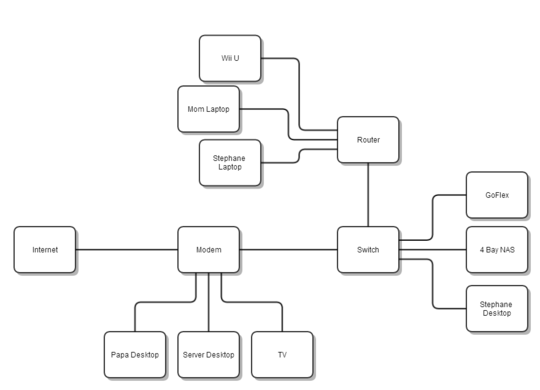1
I'm trying to set up a new home network, this is the setup I am wanting to create; because I have not purchased the switch or NAS yet, I want to know if this will work before hand.
This is the planned setup:

Basically all I want to know is if all the devices will be able to connect to the GoFlex and 4 Bay NAS in this case.
From what I understand having the NAS in the switch would act the same as having it plugged into the Modem; and because the router is also connected to the switch, the wireless devices connected to it should also be able to connect to the NAS via local IP (For example mapping network drive to 192.168.2.14)
Is this correct? Everything will be able to connect to each other? Thanks for any help!
Edit: Ok, sure! The Modem also can act as a router and provide a wireless access point, but due to it being a weak signal, we don't use the wireless on it; but it is handling DCHP addresses in the 192.168.2.1 gateway.
The Router listed in my Diagram is used used as a wireless access point, and is also handling DHCP addresses in the 192.168.1.1 range.
In my current set up (but not how I want) The GoFlex is conencted to the modem and it's local IP is 192.168.2.14; and all my devices connected to the router in the 192.168.1.x range are able to connect to it via the mapped location "\192.168.2.14\GoFlex Home Personal" so I know I can connect between subnets like this.
There is not really enough information here to answer this properly. Also you need to be more precise with your terms, e.g. when you say router what exactly do you mean, is it a Wireless access point, a cable router or something else. Also you need to be clearer about which device is handing out DHCP addresses? – hardillb – 2014-02-09T17:14:12.923
I've updated the main post; hope this helps! Thanks in advance. – Stephane Levesque – 2014-02-09T17:51:34.183
If the modem is the internet gateway, and can act as a router, I would replace the router connected to the Wii-U, Mom laptop and Stephane Laptop with another switch. Granted you could turn off the routing function of that router... possibly, but it would be a simpler home set up to have a single modem/router/gateway connect to a series of switches as needed. – JamesTheDev – 2014-02-09T18:30:18.150
The wireless in the modem is too weak to be used; and the laptops and Wii are conenected to the router via WiFi, so a switch could not be used in place of it. – Stephane Levesque – 2014-02-09T18:52:53.960